Israel’s Strategic Dilemma with Hezbollah | Jenin Operation Acclaimed as a Success | Internal Rift Threatens the IDF’s Readiness, Closely Monitored by Iran
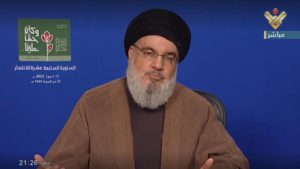
Hezbollah Secretary General Hassan Nasrallah in his speech
The Northen Front – Hezbollah’s Increasingly Daring Steps Test Israel’s Response
- In the past year, and increasingly so over the past several months, Hezbollah’s significant power buildup has been coupled with ever more daring actions designed to promote what Hezbollah defines as Lebanese interests which has been expanding due to Israel’s reluctance in confronting Hezbollah militarily. Hezbollah has repeatedly tested Israel’s response, the quality of its defense systems, and its readiness for war. During the month of July, several border encounters coupled with Hezbollah Secretary General Hassan Nasrallah’s menacing speeches, his renewed border claims and his interpretation of the domestic rift in Israeli society have increased the chances for war, albeit limited, between Israel and Hezbollah.
- Nasrallah has identified an opportune moment to test Israel aimed at bolstering his domestic status inside Lebanon, during a period of a deteriorating Lebanese economy and gradual loss of Hezbollah’s popularity against the backdrop of the internal sectorial rift, to which Hezbollah is regarded as bearing significant responsibility.
- Senior Israeli officials exclusively tell the IDSF, “Nasrallah could be plotting another action in Israel. We will not consider it as ‘Megiddo 2.0’ [a Hezbollah operative who infiltrated Israel, detonated an IED and injured one Israeli] but as the ‘Third Lebanon War’.” He continues, “Nasrallah truly believes Israel is akin to a ‘spider’s web’, to quote his famous 2006 speech, thereby he is gambling on the lack of response on the part of Israel and on its weakness.”
- Senior Israeli military officials told Ynet News that Hezbollah “has taken its bold actions to the next level and is seeking more and more opportunities to provoke the IDF on the border.”
- Israel remains prepared for war, however several developments during the month of July indicate Hezbollah’s potential intention to launch a strike against Israel in the near to medium term:
- On July 12, three Hezbollah operatives attempted to sabotage the border fence and were pushed back by the IDF by means of riot control measures. Israeli Minister of Defense Gallant confirmed these were Hezbollah operatives. The Lebanese media reported on three injured.
- On July 14, IDF surveillance cameras installed along the border fence were ripped out. Hezbollah released a video of three of its operatives climbing on the fence and waving the organization’s flag.
- On July 14 and 16, 2023, Lebanese residents went to the border near Metulla and threw rocks at IDF soldiers. The soldiers used riot dispersal measures and fired shots into the air to deter them (al-Manar, July 16, 2023).
- On July 15th, 18 Lebanese civilians including a member of the parliament crossed the Blue Line into Israeli territory in a filmed visit in the Har Dov area. They were ordered to back down by IDF troops.
- Hezbollah issued a video of its operatives simulating an attack on an Israeli post.
- On July 17, Hezbollah’s combat propaganda unit issued a video of Hezbollah’s al-Radwan force, the organization’s elite unit, simulating the takeover of an Israeli post. According to the video, the simulation began with “softening” the post by firing anti-tank missiles and mortar shells. Then dozens of Hezbollah operatives on motorcycles and driving ATVs launched the attack. After the takeover’s “successful completion,” a Hezbollah flag was raised over the post. (al-Manar)
- On July 20, a Hezbollah-affiliated news outlet published a video showing the IDF Chief of Staff and other senior officers visiting the northern border. Other pictures including senior IDF officers in crosshairs were promulgated.
- In April, Hezbollah planted 2 tents in Israeli territory near the border in the Har Dov area, or “Sheba farms” which Hezbollah claims is part of Lebanese territory. The tents were placed in the Israeli side of the Blue Line which Hezbollah does not recognize as the international border. In June one of the tents was removed. According to the Lebanese media, the next step may be the erection of more Hezbollah tents.
- Hezbollah frames this as protecting the village of Ghajar which is under occupation according to Hezbollah. Nasrallah threatened Israel if they were to remove the tent. It may be a move Nasrallah would utilize to justify a larger counter attack.
- The United Nations and the United States are involved in brokering talks between Israel and Hezbollah. One of the offers included halting by Israel of the construction of a land obstacle along the Israeli-Lebanon border in return for the dismantlement of tents by Hezbollah. However, dynamics by which Israel puts its critical security needs at risk at the behest of a terror group’s “gun on the table” is inconsistent with Israeli deterrence policy and could gravely influence the Israel-Hezbollah equation of deterrence down the road.
- Televised speeches have been typical to Nasrallah’s strategy of conveying messages and positioning himself as a spokesperson for the Shi’ite-Lebanese ideology. This tool was used by him on many occasions including when he threatened Israel not to produce gas off its gas reserves, in an attempt to instil fear among the Israeli population by boasting of Hezbollah’s rocket capabilities.
- On July 12, he delivered a speech where he referred to the tents issue, threatening Israel not to remove them. “Israel is not acting because it knows this will not go unnoticed, and our people will know what to do in case it does.”
- On July 24th, when the Israeli Knesset passed a bill as part of the judicial reform and protests broke in the streets, Nasrallah said: “Today, in particular, is the worst day in the history of the [Zionist] entity, as some of its people say. This is what puts it on the path of collapse, fragmentation, and disappearance, God willing.” In his Ashura Day sermon, Nasrallah said, “Israel was once thought of as an invincible regional power, and countries in the region accepted its threat as a fact that can’t be removed. … The Zionist entity’s trust, awareness and self-confidence have deteriorated into the crisis it is experiencing today”.

IDF Chief of Staff Herzi Halevi touring the Israel-Lebanon border, as captured by Hezbollah cameras
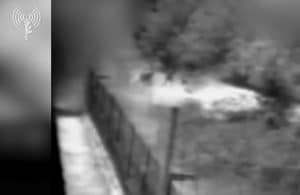
Hezbollah operatives pushed back by IDF riot control measures while attempting to sabotage the border fence (July 12) | IDF spokesperson
Significant Hezbollah Power Buildup is Israel’s Second-Largest Strategic Threat
- While the Iranian nuclear program was defined by Israel as its most pressing strategic security threat, Iranian-backed terror group Hezbollah in Lebanon is regarded as the second-most pressing one.
- Rocket capabilities: Hezbollah is estimated as possessing 150,000 rockets, missiles and attack drones, some of them are precision-guided missiles who could hit targets within several meter’s accuracy.
- Budget: It is also the richest organization in the world, with annual budget of some $1 billion USD.
- Ground offensive capabilities:
- Hezbollah has dedicated considerable efforts to transforming the dynamics of the Israel-Lebanon border for an extended period, blatantly violating UN Security Council Resolution 1701. Commencing with their initial step, the extremist group strategically positioned formations of combatants within fortified compounds along the border region. These compounds harbor a multitude of concealed armaments, encompassing anti-tank launchers, mortars, sniper rifles, explosives, and various other weaponry. Predominantly safeguarded and concealed beneath the ground, these weapons serve as a formidable strength for Hezbollah.
- Additionally, this formation witnessed the assimilation of numerous terrorists from Hezbollah’s highly skilled troop known as the Radwan force. An assortment of these formations came into existence within the confines of urban landscapes, nestled amidst the southern regions of Lebanon, stretching from the border line and penetrating the heart of the territory, designated to invade Israel or even occupy towns in northern Israel. These troops have amassed significant combat capabilities during the Syrian Civil War where they were highly involved in assisting the Assad regime on behalf of Iran and Hezbollah.
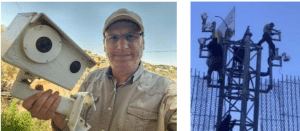
Right: Three Lebanese operatives on the IDF communications tower. Left: Hezbollah-affiliated Al-Manar’s correspondent holding one of the cameras (@alishoeib1970 Twitter account, 7/14/2023)

Hezbollah’s combat propaganda unit issued a video of Hezbollah’s al-Radwan force, the organization’s elite unit, simulating the takeover of an Israeli post (July 17)
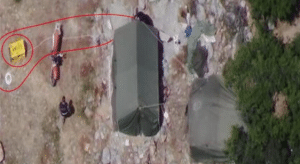
The tents erected by Hezbollah and to the left a Hezbollah terrorist operative wearing a Green Without Borders vest (Kan TV News, Israel, June 24, 2023)
“House and Garden” Operation in Jenin
- Between July 3-5, the IDF launched a counterterrorism operation in the Jenin Refugee Camp, targeting terrorist infrastructure, capabilities and wanted militants. Among other things, IEDs were destroyed, large-scale military equipment was confiscated, and terrorists were taken down or arrested. Multiple voices in the Israeli defense community expressed the need for such an activity, in order to moderate the “terrorist hotbed” threat from that area that consistently threatened both Israeli soldiers and civilians, as opposed to the daily pinpoint activities aimed at arresting or neutralizing specific terrorists as per specific information provided by the Intelligence Corps and the Shin Bet.
- The operation was completed in just two days of wide-scale but surgical fighting inside Jenin refugee camp, and resulted in the death of one Israeli soldier, David Yehuda Yitzhak and 12 Palestinian terrorists. The operation combined precision airstrikes with infantry and special forces.
- High intelligence capabilities together with the abilities of the forces enabled the IDF to conclude this operation inside the densely populated Jenin refugee camp with zero civilian deaths. Around 120 Palestinian terrorists and combatants were injured and around 30 were detained for further interrogation.
- During the operation IDF troops located and destroyed about 1,000 IEDs, mortars, communication devices, rifles and ammunition, damaged dozens of weapons manufacturing facilities and tunnel shafts. Around 14 terrorists’ houses were found as well as a few operation rooms. Alongside these findings the IDF confiscated a large sum of money totaling hundreds of thousands of Shekels (ILS) which were marked for terror funding.
- This ammunition and equipment would have been used to target Israeli civilians and soldiers as evidenced by the multiple attacks by Palestinian terrorists that have ultimately led to this operation.
- The operation also highlighted once again the use of civilian settings as human shields for terrorist purposes. Two tunnel shafts were located inside a mosque, and the meeting point of top Jihadi militants in the camp, that was targeted during the preliminary air strike that launched the operation, was located near the vicinity of a UNRWA school.
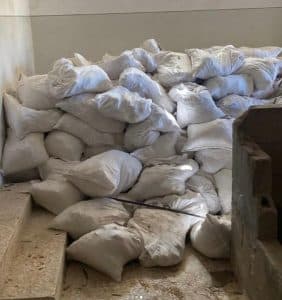
Tunnel shafts hiding ammunition inside a Jenin mosque. In a statement, the IDF Spokesperson said, “Holy places, such as the Al-Nasr Mosque, should not be used as a front for terrorism. Packed with loads of ammunition, and two underground pits containing explosive devices, this is just one example of how terrorists abuse the citizens of Jenin.”
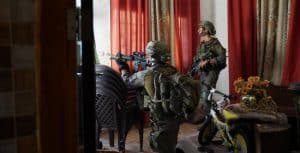
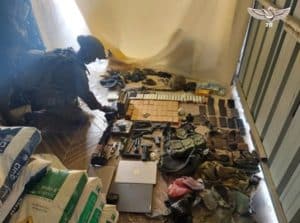
Israeli Soldiers in Jenin, confiscated ammunition | IDF Spokesperson
International Criticism and the Identity of the Killed Palestinians
- In response to the operation, voices in the international community condemned Israel for its actions in Jenin, often with no relevant context such as terrorist capabilities that have become a consistent, deadly threat for Israeli soldiers and citizens, nor the prudence of the IDF to avoid civilian casualties.
- The UN Human Rights Chief Volker Türk referred to “killings”, with no relevant context of terrorism, and stressed Israel’s imperative to “ensure timely access to medical care to all those injured during the violence” without referring to the IDF’s actions. Namely, the IDF enabled the passage of civilians and evacuated injured civilians into the Israeli hospital Rambam in the city of Haifa. However, the UN official said that “the killing, maiming and the destruction of property must stop,” saying the scale of the Israeli operation “raised a host of serious issues” regarding international human rights standards. He insinuated accusations by raising the question that some deaths “may also amount to willful killings”. He called on Israel to “minimize, to the greatest extent possible, resort to force and in particular lethal force.” UN Secretary General Guterres accused Israel of using “excessive force”.
- European Union representative to the Palestinian territories Sven Kuehn von Burgsdorff said he was ” concerned about the deployment of weaponry and weapons systems which question the proportionality of the military during the operation.”
- The White House said in a statement that the United States supports “Israel’s security and right to defend its people against Hamas, Palestinian Islamic Jihad, and other terrorist groups.”
- Some media outlets also accused Israel of “killing children”, given that some of the killed Palestinian militants who fired at IDF soldiers were ranged from 16-18 years old.
- The identity of the killed Palestinians has been exposed An analysis of the names as conducted by the Meir Amit Intelligence and Terrorism Information Center revealed that of the 12 killed Palestinians, all belonged to a terrorist organization, without even one civilian death: 4 were affiliated with the Palestinian Islamic Jihad (PIJ), 3 with the Al Aqsa Martyr Brigades (AAMB), 2 with Fatah, 1 with Hamas, 1 with both Fatah and the PIJ and 2 other militants with no affiliation.
- Of the minors killed in the operation, aged 16 and 17, two belonged to the PIJ and one to Hamas, as claimed by these groups’ official agencies. Albeit minor as per the UN definition, these militants were sufficiently mature to use weapons, become active in internationally-recognized terror groups, and threaten Israeli soldiers’ lives by firing live ammunition at them. This should also raise serious questions as to how the international community is dealing with terrorist groups’ recruitment of minors to the battlefield.
- The Palestinian fatalities, the circumstances of their deaths and their organization affiliations were the following:
- Samih Firas Abu al-Wafa, 20, AAMB operative, as claimed by the Fatah

-
-
- Aws Hani Hanoun, 19, PIJ operative as per the group’s website
- Husam Muhammad Abu Deibeh, 18, Fatah and PIJ operative as per the groups TV and website
- Nur al-Din Husam Marshoud, 16, PIJ operative as per the group’s website
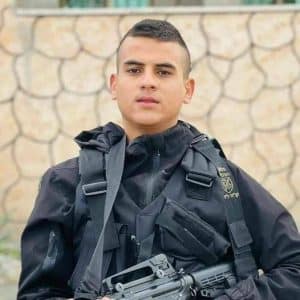
- Muhammad Muhannad Shami Turkman, 23, AAMB operative as per the group’s Telegram channel and Turkman’s Facebook account
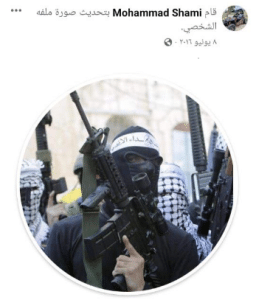
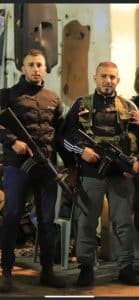
- Ahmed Muhammad Amer, 21, AAMB operative as per the group’s Telegram channel and his Facebook account

- Majdi Yunes Ararawi, 17, PIJ as per the group’s website
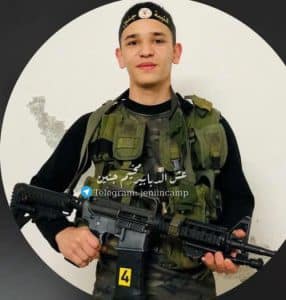
- Ali Hani al-Ghoul, 17, Hamas’ Izz al-Din Qassam Brigades operative as per the group’s statement
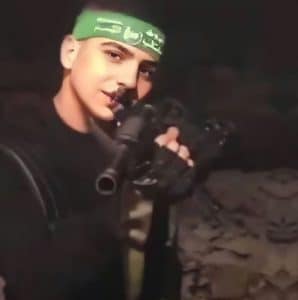
- Mustafa Imad Qassem, 16, no known organizational affiliation, but his Facebook page subject picture is a caption supporting Shahada (Martyrdom)
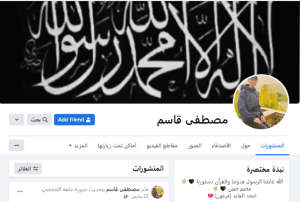
- Uday Ibrahim Khamayseh, 22, Fatah
- Abd al-Rahman Hassan Hardan Sa’abneh, 22, PIJ as per the group’s Telegram channel
- Jawed Mujahed Neirat, 22, no known organizational affiliation
-
Conclusions
- The operation proved Israel’s capacity to target terrorist nests deep inside PA territories, while highlighting the significant scope of this infrastructure thanks to Iranian support, and the continuous incitement on the part of Palestinian terrorist groups and the Palestinian Authority itself, with its “Pay for Slay” policy – paying monthly stipends to terrorists as a reward. The erroneous notion that the PA can take responsibility over these territories with no IDF intervention has been proven moot, and the IDF is forced to “clean up after” the PA.
- For its part, the Palestinian Authority refrains from any meaningful steps to target terrorism, and is dedicating most of its efforts to condemn Israel and threaten to halt the security coordination – which mainly benefits the PA itself. Yet despite the above, voices in Israel still support the maintenance of the PA, while failing to address the changing reality.
- For the State of Israel, as long as terrorism persists, the IDF will be obligated to conduct intense, high-risk quality operations, with no guarantee of long-term elimination of terrorism. Unless operations are incorporated into a comprehensive strategy that also includes an increase in the presence of the IDF in strategic axes and the establishment of roadblocks, better surveillance of Palestinians entering Israel in order to make it harder for them to launch attacks within the Green Line areas, and the encouragement of the Palestinian population to reject terrorist operatives, the threat to Israeli security will remain.
Aftermath
- Donations: In the aftermath of the operation, Algeria declared a pledge of $30 million for the Jenin Refugee Camp, while the United Arab Emirates (UAE) declared its readiness to provide $15 million. However, residents of the camp expressed doubts as to whether the funds would be allocated to the camp. They suggested that the funds would likely be used to pay salaries to the Palestinian Authority, rather than for the refugee camp.
- Palestinian Authority: PA and Fatah ‘old guard’ representatives were ousted from the camp when they attempted to participate in the funerals of the terrorists following the withdrawal of the Israeli forces from Jenin. In reaction to that chairman Abbas paid a visit to Jenin and the presence of Palestinian security forces in the refugee camp was restored at least temporarily. Abbas reportedly directed the Palestinian Authority security services to establish a presence in the area. In an internal meeting, he warned Majd al-Faraj, the head of Palestinian General Intelligence, and his agents that if they did not act quickly, Hamas would regain control of the area, similar to the situation in 2007 when it took over the Gaza Strip. Official sources reported that Abbas accused Faraj of being responsible for the loss of control over Jenin and its Refugee Camp. The agreement was that a major “shake-up” would be made to the security services’ operations in Jenin, which was essential if the PA wanted to get the money promised by Algiers and the UAE to rebuild Jenin.
- On top of that, Abbas called for representatives of the Palestinian factions to meet in Cairo on July 30th and accepted Turkey President Erdogan’s offer to meet Hamas leader Haniyeh. The three of them met in Turkey on July 26th. In the meanwhile, Hamas boasted of its attempt to launch more terror attacks from the Judea and Samaria area while the preparation of new terror infrastructure in Jenin has begun.
Threats on Refusal to Serve – a Threat to Israel’s Stability
- The disagreements inside Israel regarding the judicial legislation brought with it huge demonstrations and disruption of the public order. A dangerous phenomenon was the threat by some reservists to not volunteer if the legislation is enacted. The Israeli chief of general staff warned that this may harm the cohesiveness and the preparedness of the IDF.
- US President Biden repeatedly referred to the political tension calling on the government to guarantee ‘a broad consensus’ before moving forward with the legislation. This intervention reflected the tense relations between the administration and the Israeli government. In an attempt to present a warmer tone between the allies, Israeli President Herzog was warmly greeted in Washington and President Biden spoke with Prime Minister Netanyahu and said that he is going to meet him in the coming months in the US.
- As Israel faces with many demanding challenges, unequivocal US support and commitment to its security is more necessary than ever.
US on its way to grant Visa waiver to Israelis?
- In a policy change that it hopes will allow Israel to join the US Visa Waiver Program, (VWP), and secure visa-free entry for Israelis to the US, Israel announced that it will begin granting entry to all US citizens, including all Palestinian Americans living in Judea and Samaria and the Gaza Strip.
- This step is taken after the American administration set this requirement as a condition for Israel the VWP.
- From the Israeli perspective, this decision will create a new challenge for the security services – terror activists can use this unsupervised movement for inter-organization and regional cooperation or even in conducting terror attacks. Effectively, the US forced Israel to lift its travel ban from Gaza to Israel, the PA and any other location around the globe.
The Monitor: July 2023 in numbers
On the Israeli Side:
2 Soldiers killed in action
9 Wounded civilians – Car ramming and stabbing
July 4 | Tel-Aviv |A 22-year-old Palestinian male drove a vehicle against traffic on a north Tel Aviv street, jumped onto a sidewalk near a bus stop, and crashed into a crowd of people waiting to board a bus. The assailant exited the vehicle with a knife in his hand and began stabbing people before being shot dead by a civilian armed with a gun. Nine people sustained injuries, five of them critical, including a 46 year old pregnant woman whose fetus did not survive the attack. The assailant used his employer’s vehicle to carry out the attack.
July 6 | Har Gerizim |A drive-by shooting on a police patrol car and a police station in Samaria, south of the Nablus area. No injuries were reported. The patrol car and the police station were found with bullet holes. The terrorists fled and the IDF initiated a manhunt.
July 6 | Qdumim | The control center of the Qdumim settlement reported the existence of a suspicious vehicle circling the settlement, seemingly attempting to gain entry. The settlement was placed on lockdown and its inhabitants were advised to remain indoors. An Israeli Defense Force (IDF) unit was sent to investigate the driver, who exited the vehicle armed with a pistol and opened fire on the IDF soldier, and fatally wounded him before fleeing the scene. IDF forces pursued the suspect, who was subsequently shot and killed. Eventually, the Israeli soldier died from his wounds. Hamas took responsibility for the action.

Staff Sgt. Shilo Yosef Amir, 22
July 10 | Jerusalem | A Palestinian woman in her mid-60s entered a Light Rail Station in Jerusalem, where she drew a knife from her purse and threatened a security guard. The guard ordered the woman to stop and drop the knife, and fired a warning shot into the air when she did not comply. The woman, who resided in east Jerusalem and had an Israeli ID card, sustained a superficial wound to her leg and was evacuated to a local hospital. She was reportedly cognitively impaired and had been apprehended in the same area two months prior.
July 10 | Dir Qadis | An Israeli civilian group entered Dir Qadis village. While in the vicinity, a Palestinian assailant pulled a knife and attempted to stab one of the Israeli civilians. The Israeli Defense Force initiated a search for the assailant.
July 10 | Dir Nidham | An IDF force operating at the Dir Nidham checkpoint became suspicious of an unidentified vehicle and requested the driver to stop. The driver exited the vehicle, threw a hand grenade, and fired with an improvised machine gun at the force, resulting in the attacker being shot and killed. Fatah movement issued notice that Bilal Ibrahim Qadah, the man who was killed was a member of the movement.
On the Palestinian side – counterterrorism operations
July 3-5| Jenin | 48 hours “House & Garden” IDF operation in Jenin and Jenin refugee camp. 1 Israeli soldier killed, 12-18 killed terrorists, around 120 injured Palestinians, around 30 suspects detained.
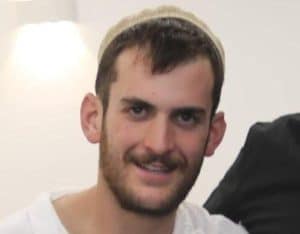
Sgt. First Class David Yehuda Yitzhak, 23
July 7| Nablus | In order to apprehend two individuals suspected of perpetrating a shooting attack in the Samaritan neighborhood of Har Gerizim in Nablus on July 5th, 2023, Israeli security forces conducted a raid into the Old City. The two were found, refused to surrender and fired at the forces. As a result of the exchange of fire, both men, Kheiri Shahin and Hamzeh Maqbul, were killed in the crossfire. During the raid, two handguns were discovered, which were apparently used by the suspects to carry out the attack.
Shahin is an ex-convict, served four years term in the Israeli prison.
Both Abu Ali Mustafa Brigades, the military-terrorist wing of the Popular Front for the Liberation of Palestine (PFLP) and the al-Aqsa Martyrs’ Brigades (AAMB) claimed responsibility for their terror attack at Har Gerizim.
The full stats – Terrorism 2023
Closing first half of 2023, we will provide here full statistics of terror attacks against Israelis. Most of the data is based on Hatzala – Rescuers Without Borders report. (https://t.me/hatzhalhyosh)
The data is to January-June, 2023, 181 days in which conducted over 3,640 terror attacks, 28 Israelis murdered and 362 injured.
Statistically speaking, in the first half of 2023, two Israeli civilians were harmed by terror each day.
Judea & Samaria:
- 2118 Rock throwing
- 799 Molotov cocktails
- 342 Burned tires rolling
- 286 IED’s
- 185 drivers targeted by blinding lasers
- 101 Shooting attacks
- 81 Fireworks shooting
- 67 Arson cases
- 20 Paint bucket throwing – obstructing driver’s vision
- 3 Car ramming
- 1 IED (Claymore mine-like device)
Terror attacks in rest of Israel:
- 1666 Rocket launches
- 6 Shooting attacks
- 4 Stabbing attacks
- 3 Car ramming
- 2 Molotov cocktail throwing